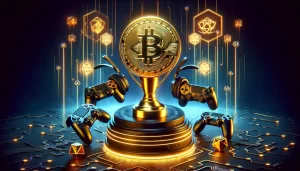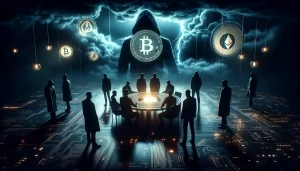Play-to-earn (P2E) gaming is an emerging concept that merges entertainment with income opportunities. Using blockchain technology and NFTs (non-fungible tokens), these games allow players to earn real-world value through participating in virtual economies. This article will demystify P2E gaming and analyse how it is evolving video game economics.
Demystifying Play-to-Earn Gaming
Core Concepts and Mechanics
The core premise of play-to-earn games is that players can generate tangible income whilst enjoying the gameplay. Popular P2E titles like Axie Infinity create in-game assets as NFTs hosted on blockchains like Ethereum. This provides transparency and scarcity, allowing the assets to hold real-world value that players can realise.
The play-to-earn model relies on players being incentivised to actively participate in the in-game economy. Activities like battles, breeding rare NFTs, and referrals are tied to cryptocurrency or token rewards. These have value outside the game that players can exchange for fiat currency.
Real-World Income Potential
Whilst still early, P2E gaming is demonstrating some real-world earning potential. For example, Axie Infinity has reportedly become a vital source of income for many in the Philippines. By playing P2E games, these users are able to supplement livelihoods and provide for families.
As evidence of income potential, Yied Guild Games believes “NFT games are doing more to deliver financial inclusion than a bank account ever has or will.” However, more mainstream adoption outside of niches is still needed.
Evolution of Gaming Economics
Transition Towards Digital Economies
Gaming has undergone a rapid shift from physical goods and single-point purchases towards an emphasis on digital goods and services. Recurrent spending models like in-game skins have become integral to titles like Fortnite. Games are now seen as long-term platforms rather than discrete products.
With increasing “assetization”, virtual assets now make up complex in-game marketplaces. However, ownership has traditionally been confined within each game’s closed ecosystem. Blockchain and NFTs present an avenue to transition them into decentralized digital economies.
Play-to-Earn as a Paradigm Shift
Play-to-earn decentralizes gaming economies by enabling player-driven markets for virtual assets. This shift ultimately transitions incentives from pure entertainment value to include wealth creation for participants. It blurs the lines between playing games and contributing to blockchain-based economic structures.
Whilst still speculative, some believe this paradigm shift could profoundly reshape gaming business models. Much depends on continued innovation in blockchain scalability and game design to provide sustainability. Nonetheless, P2E presents intriguing possibilities for economic inclusion compared to traditional models.
Opportunities and Use Cases
Secondary Marketplaces
By enabling true ownership of virtual assets, play-to-earn gaming opens up secondary marketplaces for trading outside centralized closed ecosystems. For example, NFTs acquired in one game could be sold in a third-party decentralized exchange like OpenSea.
Some benefits of secondary NFT market integration include improved price discovery compared to arbitrary in-game valuations, lower fees due to blockchain efficiency, and developers avoiding the need to build isolated marketplaces. There is also evidence of demand – a survey found 63% of gamers would spend more if assets held real-world value.
Community Ownership
Play-to-earn also facilitates participatory community models compared to traditional centralized authority. Decentralization enables players to be directly involved in shaping ecosystems, similar to a transition towards Web 3.0.
For example, decisions on new NFT releases, gameplay changes, and metaverse expansions can be put to token holder votes. Whilst balancing different interests remains challenging, this democratization creates a symbiotic dynamic between players and developers. Ongoing participation is incentivised.
Beyond Entertainment
Once secondary marketplaces integrate virtual gaming assets with the global crypto markets, a range of intriguing possibilities emerge. NFTs acquired in one game could end up showcased in a digital art gallery or influencing economies in unrelated games.
Interoperability between different decentralized platforms allows unique bridging opportunities. However, seamless asset flow between apps built on separate isolated blockchains remains challenging. As infrastructure improves, asset portability could reinforce positive feedback loops and user lock-in across an integrated ecosystem.
Conclusion
In closing, decentralization brings some unique possibilities to gaming’s evolution towards service-based digital economies. Although still early and not without risks, play-to-earn models are demonstrating new ways to align incentives around participation.
Ongoing issues like blockchain scalability constraints and speculative volatility need to be overcome. But if gaming can harness user contribution and creativity alongside engineering breakthroughs, there is scope for profound innovation in creating open, sustainable and equitable decentralized virtual worlds.
FAQs
What are Non-Fungible Tokens (NFTs)?
NFTs are unique blockchain-based assets representing ownership of digital items like art, collectibles, or game items. Their verifiable scarcity allows them to hold real-world value.
How can players earn money from play-to-earn games?
By participating in virtual economies, players can earn NFT asset rewards or cryptocurrency tokens with market value. These can be exchanged for regular currency through crypto trading platforms.
What risks exist around play-to-earn gaming?
Speculative trading brings volatility risks and potential market crashes. Games also face challenges keeping economics balanced sustainably, covering development costs and maintaining quality incentives to preserve engagement long-term.
What is needed for mainstream adoption of play-to-earn gaming?
Seamless onboarding, predictable tokenomics aligned to player incentives, appealing game design leveraging community strengths, and network effects driving sufficient economies of scale amongst users and developers.
Is play-to-earn gaming here to stay?
If structural problems of blockchain networks can be solved, the model offers promise. Alignment of participant incentives and community contribution suggest there will be continuing evolution leveraging these principles. Execution remains key.




